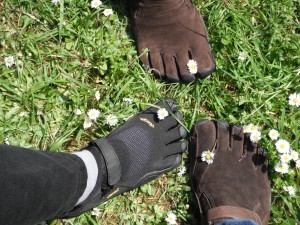Grow a “Greener” Lawn or “Eco-lawn”
Not long ago I was at a local hardware store with my husband and a friend, who my husband often helps with home repair & maintenance. The friend wanted my advice on a pesticide for his lawn. My initial response was that since I try to be mostly organic, I am not up to date on pesticides. I, personally, always cringe when I walk down that aisle knowing that many of those chemicals will end up in our streams and in Puget Sound.
This friend had some brown patches in his lawn and thought he needed something for crane flies. I pondered this for a second then asked him: “How do you know you have crane flies?” I explained that proper diagnosis is essential before applying any pesticide. Not only is misapplying pesticides bad for the environment, it wastes money. He agreed to have me come back to his house to investigate. I cut out a square of his turf and flipped it over—there was no sign of crane fly larvae or their “leatherjacket” pupae.
So what was causing the brown spots? He said it always seemed to happen during the hottest part of the summer. He uses a reel mower and always cuts the grass very short. We keep trying to tell him he needs to “cut it high and leave it lie.”—but his trimmer even at the highest setting only leaves about an inch of the grass blade remaining. That is not much photosynthetic surface for a plant to be able to maintain itself and develop a good root system. Hot summer days puts the grass under even more stress. We try to convince him to use his rotary mower and let the grass grow higher so it has a chance to develop a better root system. –After more discussion, we also figured that some of the brown spots may be due to frequent visits by their daughter’s dog.
I further recommended that he scratch up the dead grass and buy some grass seed to sow in the dead areas; but he was worried that the new grass would be a different shade of green.
Lawns and turf help create great places for playing outdoors and provide a safe place for toddlers to explore. What kid doesn’t love rolling down a grassy hillside? Can you recall the feel of running barefoot in a lush, green lawn? It is estimated, however, that homeowners use 10 times more pesticides per acre than farmers, which is not good for people, pets or wildlife. Gas-powered lawn equipment adds to air and noise pollution. An estimated 10,000 gallons of precious water is applied to suburban lawns each year. Lawns also provide little benefit or ecological diversity for local wildlife.
Fertilizing lawns with natural organic, slow-release fertilizers helps to limit excess nitrogen and phosphorus from leaching into groundwater and avoid algal blooms downstream. Tagro is great for lawns especially after aerating.
Unless you want a play surface, I usually recommend planting native trees, shrubs and groundcovers and/or a ”food forest” and garden that will provide fresh fruits & vegetables. The aesthetic suburban ideal of a perfectly manicured, weed-free lawn is just not environmentally sustainable. An “eco-lawn” is a good alternative for those who still want a lawn. It is a mixture of shorter, drought-tolerant grasses and flower seed that does not have to be watered, mowed or fertilized as often.
The Tacoma-Pierce County Health Department has some excellent publications on natural yard care. Their bulletin Natural Lawn Care discusses grass selection, mowing, fertilizing, watering and more…
(This article was first published in the Peninsula Gateway on September 12, 2012 as “Growing a ‘greener’ lawn doesn’t mean you have to use pesticides.”)



I have purchased eco lawn seed from Nichols Garden Nursery which is called northern ecology lawn mix. It has Highland Colonial Bentgrass, strawberry and micro clover “pipolina”, Roman Chamomile, wild English daisies, yarrow, baby blue eyes. I will be using it on our side yards on the north and south side of the house.
I have used their Dryland Ecology Mix. It is good for the Pacific Northwest’s “Cool Mediterranean Climate.”
Nice article but where is the list of what to grow in the eco lawn? What type of grass? Which flowers add to the lawn? Would like to know where to start on this.
Most of the research on eco lawns came out of Oregon State University. There are 2 suppliers that I know of that have good mixes: https://www.nicholsgardennursery.com/store/product-info.php?Dryland-Ecology-pid1167.html and https://ptlawnseed.com/collections/eco-and-alternative-lawns/products/fleur-de-lawn
Hi Julie,
were converting our lawn to an eco friendly clover lawn. we got everything we needed from Pro Time lawn seed in Portland. They have a great website as well. Good luck!
deb